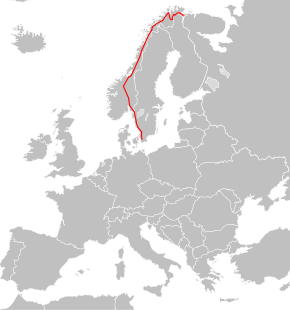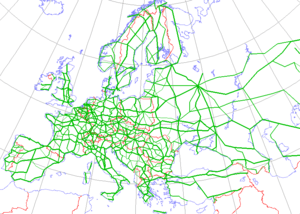European route E6
| |
|---|---|
 | |
| Major junctions | |
| North end | Kirkenes, Norway |
| South end | Trelleborg, Sweden |
| Location | |
| Countries |
|
| Highway system | |
| International E-road network | |
European route E6 (Norwegian: Europavei 6, Swedish: Europaväg 6, or simply E6) is the main north-south road through Norway, and the west coast of Sweden. It is 3 088 km (1.919 mi) long and runs from the southern tip of Sweden at Trelleborg, into Norway and through almost all of the country north to the Arctic Circle and Nordkapp.[1] The route ends in Kirkenes close to the Russian border.
Route
From south to north, E6 runs through Trelleborg, Malmö, Helsingborg, Halmstad, Gothenburg, Svinesund in Sweden, before crossing the border at the Svinesund Bridge into Norway. It then passes Halden, Sarpsborg, Moss to the capital Oslo. North of this, it passes by Gardermoen, Hamar, Lillehammer, Dombås, Oppdal, Melhus to Trondheim.
Beyond Trondheim, the E6 meets Stjørdal, Verdal, Steinkjer, Grong, Mosjøen, Mo i Rana, Saltdal, Fauske and Hamarøy towards Bognes, where there is a ferry crossing over the Tysfjorden to Skarberget. It then runs through on via Narvik, Setermoen, Nordkjosbotn, Skibotn and Alta to Olderfjord, where European route E69 continues north towards Nordkapp. The E6, meanwhile, turns south towards Lakselv and Karasjok, then runs on the west bank of the Anarjohka, which forms the border with Finland. Beyond the border, it passes through Varangerbotn, and Kirkenes, where the road terminates just east of the town center.
Between Trelleborg and Kirkenes, there is a more than 800 km (500 mi) shorter route using E4 and E75, among the longest detour any European route has. In Finnmark there are several shorter alternative routes to the E6.
Features

The road is a 2+2 lane motorway from outside Trelleborg to Kolomoen south of Hamar, about 690 km. The Swedish E6 motorway and the Norwegian motorway up to Kolomoen were completed in 2015.[2][3] This motorway is also connected to central Europe by uninterrupted motorway (via E20). Some stretches further north also have four lanes or motorway standard. The rest of the road is ordinary road, usually 6–10 m wide. Some parts in the north of Norway are less than 6 m (20 ft) wide, making it very tight when heavy vehicles meet. The northern half of the road, north of Trondheim, is also often fairly curvy, making high speeds in such parts a possible safety hazard.
E6 passes over treeless mountain passes in a few places in Norway. In the winter, bad weather and snow storms can cause the road to be temporarily closed, though unlike many minor roads, it is kept open wherever practical.[4] Because the road is the main artery through the country, cyclists and leisure travellers avoid the southern sections owing to the excessive traffic, though in the north traffic is sparse anyway.[5]
History
This road was called E 6 in the old "E" road system before 1975 and previously continued to Rome (introduced in Sweden 1962 and in Norway 1965).
It was given the number E 47 (but not signposted) in the new system on most of the Scandinavian part (Helsingborg–Olderfjord), and E 6 only for the northernmost 460 km (290 mi) (from Olderfjord in Finnmark). After a political negotiation, the whole part passing through Scandinavia was given the number E 6 in the new system, introduced in Scandinavia in 1992.
The E6 became 4-lane motorway all the way from Trelleborg to Kolomoen (near Hamar) in 2015,[2] although the road is sometimes wider. The new Svinesund Bridge opened in 2005, replacing an earlier and narrower bridge from 1946.[6]
References
- ↑ "Top 10 Drivers' Drives". National Geographic. Retrieved 3 August 2016.
- 1 2 "Motorväg genom hela Bohuslän" (Press release) (in Swedish). Swedish Transport Administration. 6 July 2015. Retrieved 6 November 2017.
- ↑ Kind, Hanne Stine; Eide, Stein S. (25 June 2015). "Sju års E6-ventetid er over". NRK (in Norwegian). Retrieved 5 November 2017.
- ↑ Lonely Planet : Norway. Lonely Planet. 2011. p. 415. ISBN 978-1-742-20472-7.
- ↑ "Norway". International Cyclist. Retrieved 3 August 2016.
- ↑ "Strait Crossings 2001". CRC Press. 2001: 173. ISBN 978-9-026-51845-4.
External links



